The animal kingdom provides so much diversity that it’s almost impossible to keep track of all the different species in the world. Sometimes the distinction between close relatives is too hard to even notice. But different species often evolve in similar ways because of their environment.
We at Bright Side gathered 16 pairs of animals who are almost indistinguishable from each other at first sight in order to show you the differences between them.
1. Jaguar vs leopard
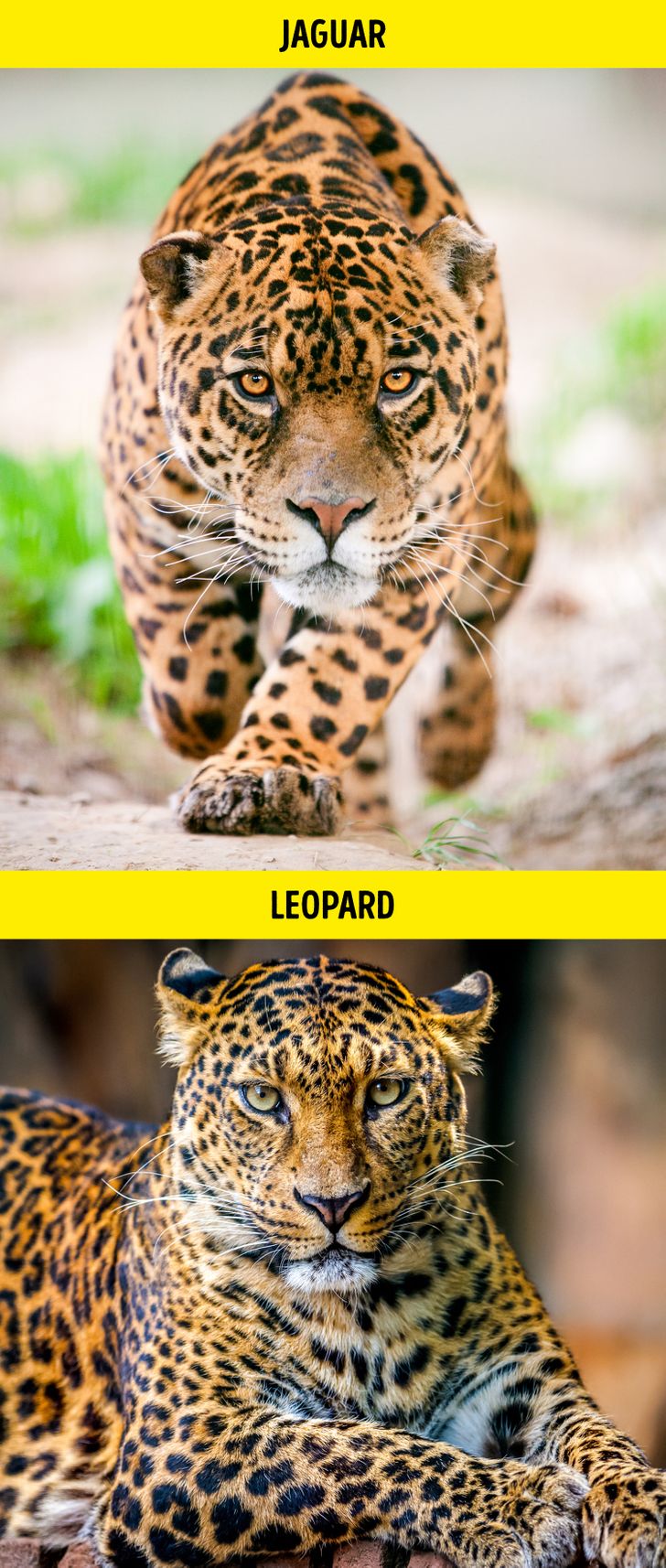
Despite their similarities, these big cats inhabit different continents and climate zones: leopards live in African savannas, while jaguars dwell in South American tropical forests. Jaguars are also larger and bulkier, and unlike leopards and many other cats, they’re fond of water.
2. Alligator vs crocodile
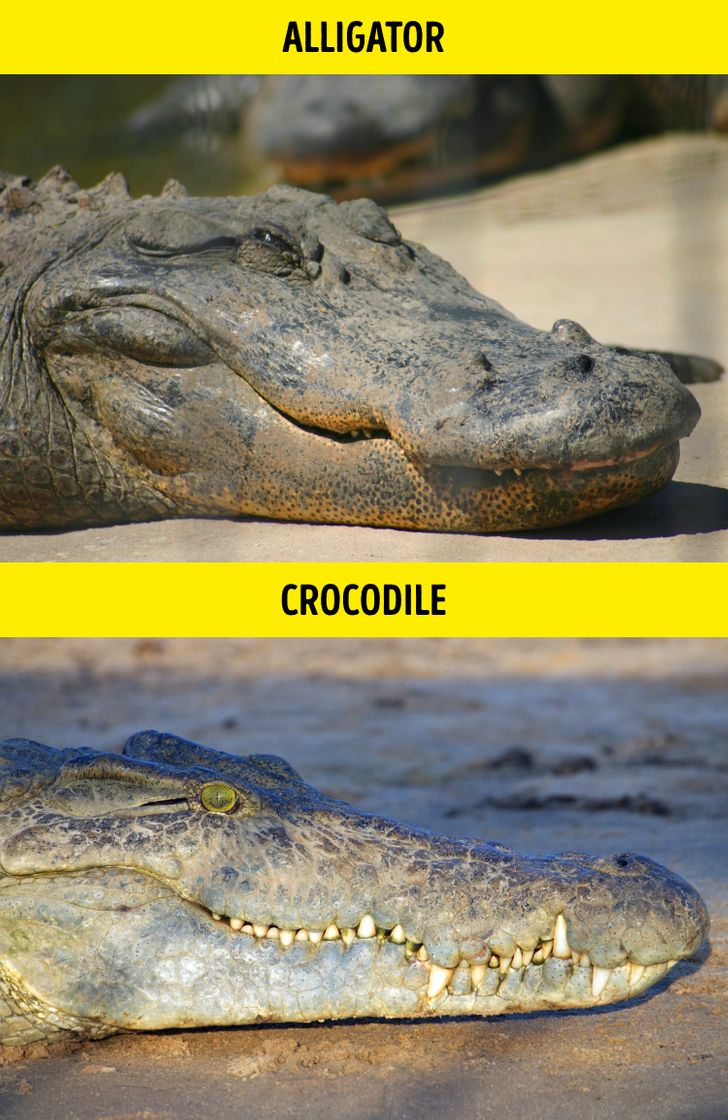
You can easily identify these 2 by the shape of their snouts: crocodiles have prominent, elongated V-shaped faces while alligators have shorter, wider U-shaped ones. Also, consider the teeth: crocodiles display their trademark toothy “grin” with every fourth tooth visible. Conversely, the alligator’s upper jaw is broader than the lower one, so its teeth aren’t visible for the most part.
3. Wasp vs hornet
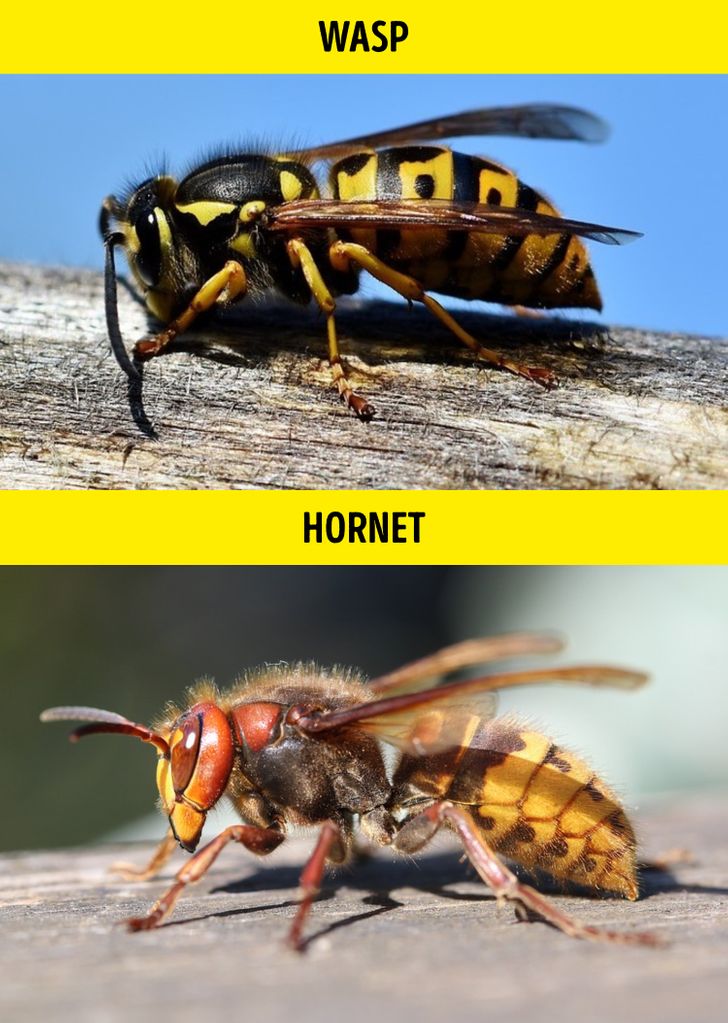
Both insects are menacing, that’s for sure. Hornets are larger and boast orange and black coloring, resembling spots rather than stripes, while wasps are more brightly colored and have yellow and black rings. You’re better off avoiding both.
4. Seal vs sea lion
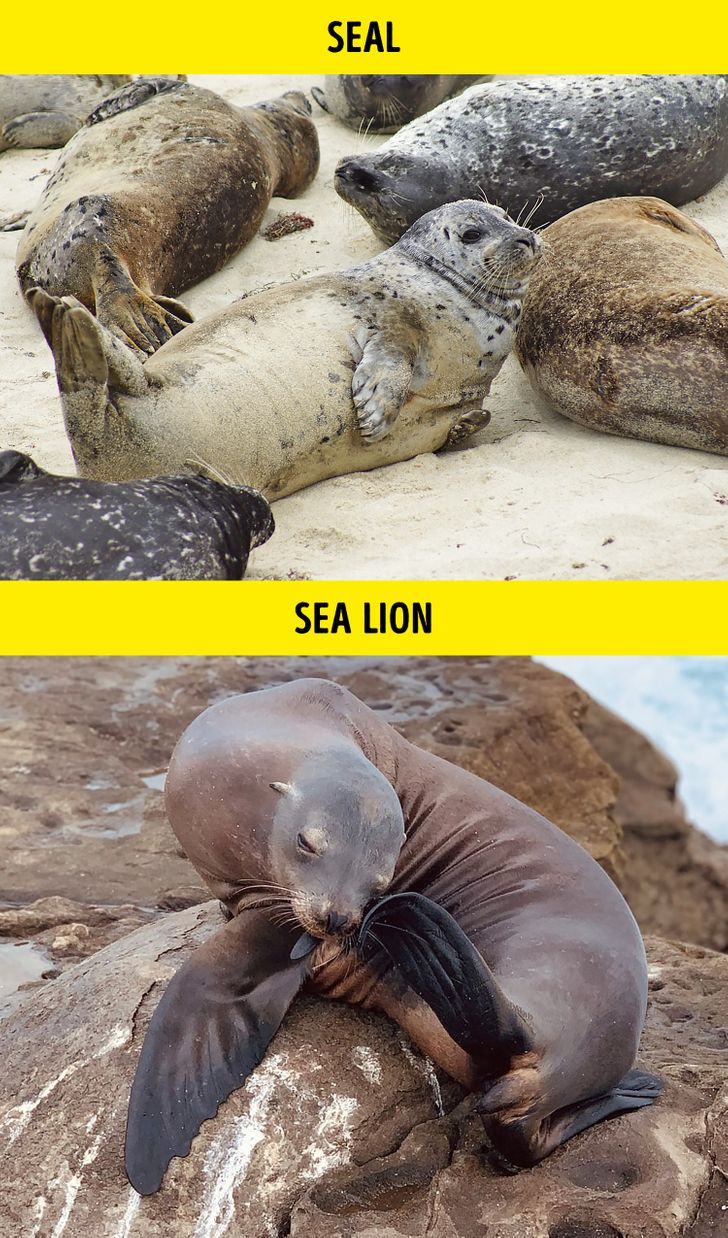
You’ve most likely met seals as cute plushy animals and sea lions as circus acrobats. Seals are covered with fur and have tiny front flippers which prevent them from walking, forcing them to wiggle on their bellies. Sea lions have smooth skin and vast flippers that they use to move on the ground.
5. Turtle vs tortoise
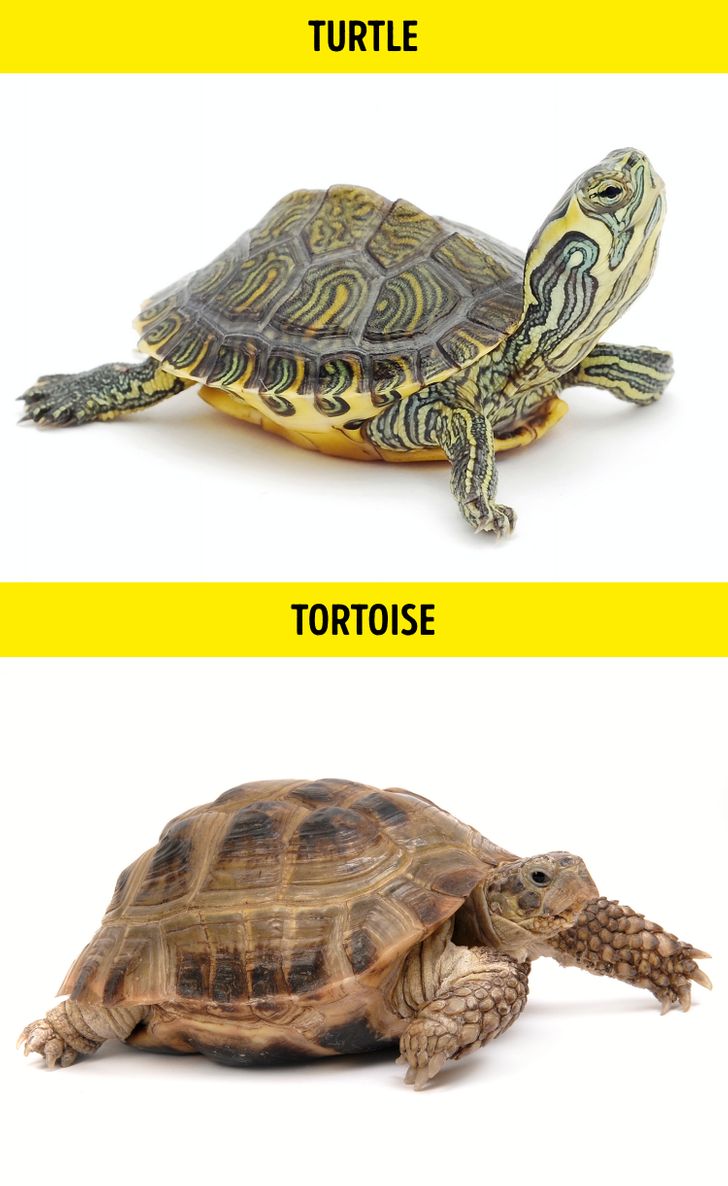
These 2 are both mobile (but very slow at that) and boast 4 legs. But the “turtle rock” is aquatic and has markings that resemble stains and circles on the water to better hide in the ponds. The “tortoise rock” is a land animal and spends most of its time on the ground — that is, as a literal rock.
6. Raven vs crow vs rook vs jackdaw

Most corvids look fairly similar (excluding jays who are like a theatre kid in a goth family). Ravens are the loftiest and most fashionable thanks to their “beard” of throat feathers. Crows and rooks are of the same size, but rooks have a distinct grey beak and fancy feather “pants” on their legs. Jackdaws are the goofiest-looking thanks to their very short beaks and a round heads with black caps.
7. Donkey vs mule
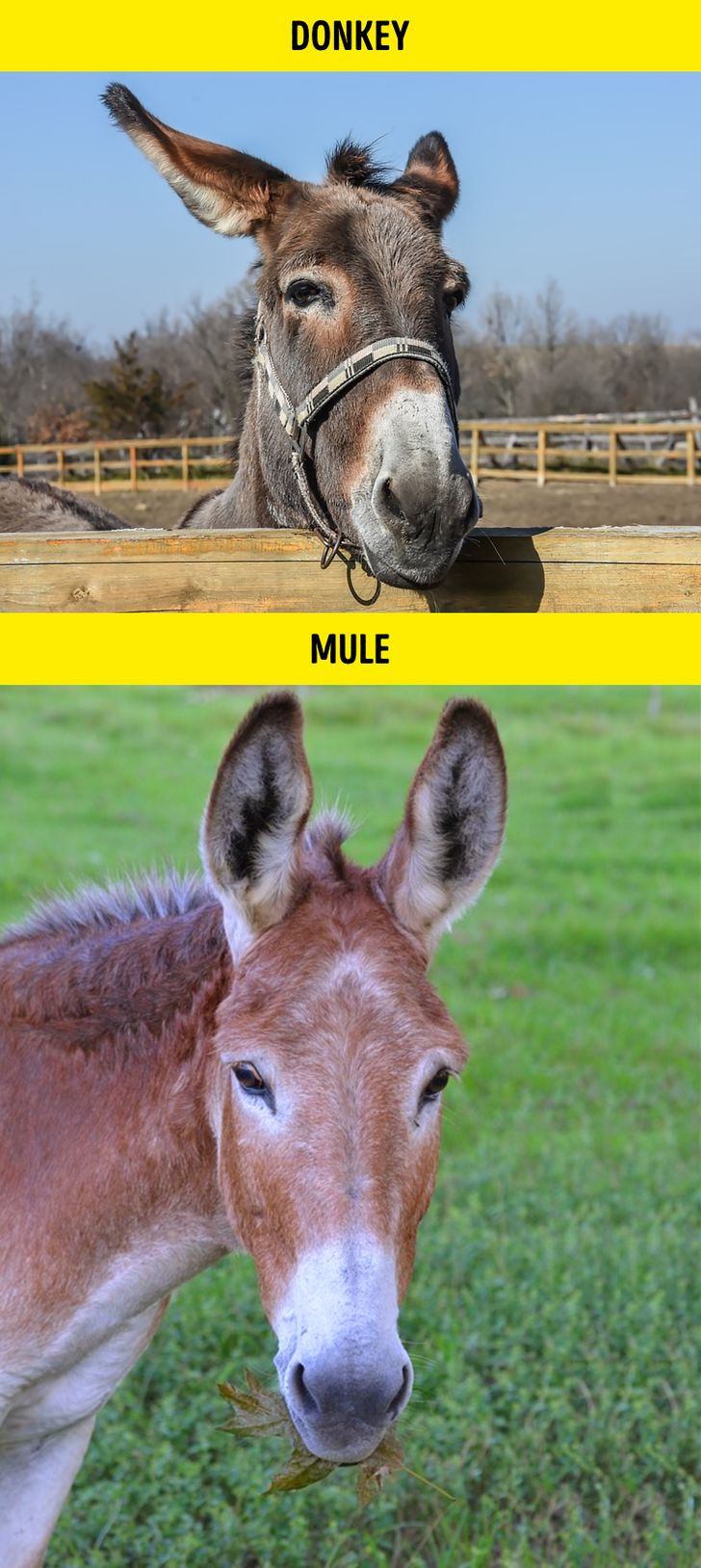
This one is tricky for a simple reason: while the donkey is its own species, a mule is a hybrid of donkey and horse. Funnily enough, it looks exactly like what you’d think these 2 animals would look like: an elegant head of a horse with ridiculously oversized donkey ears.
8. Hare vs rabbit
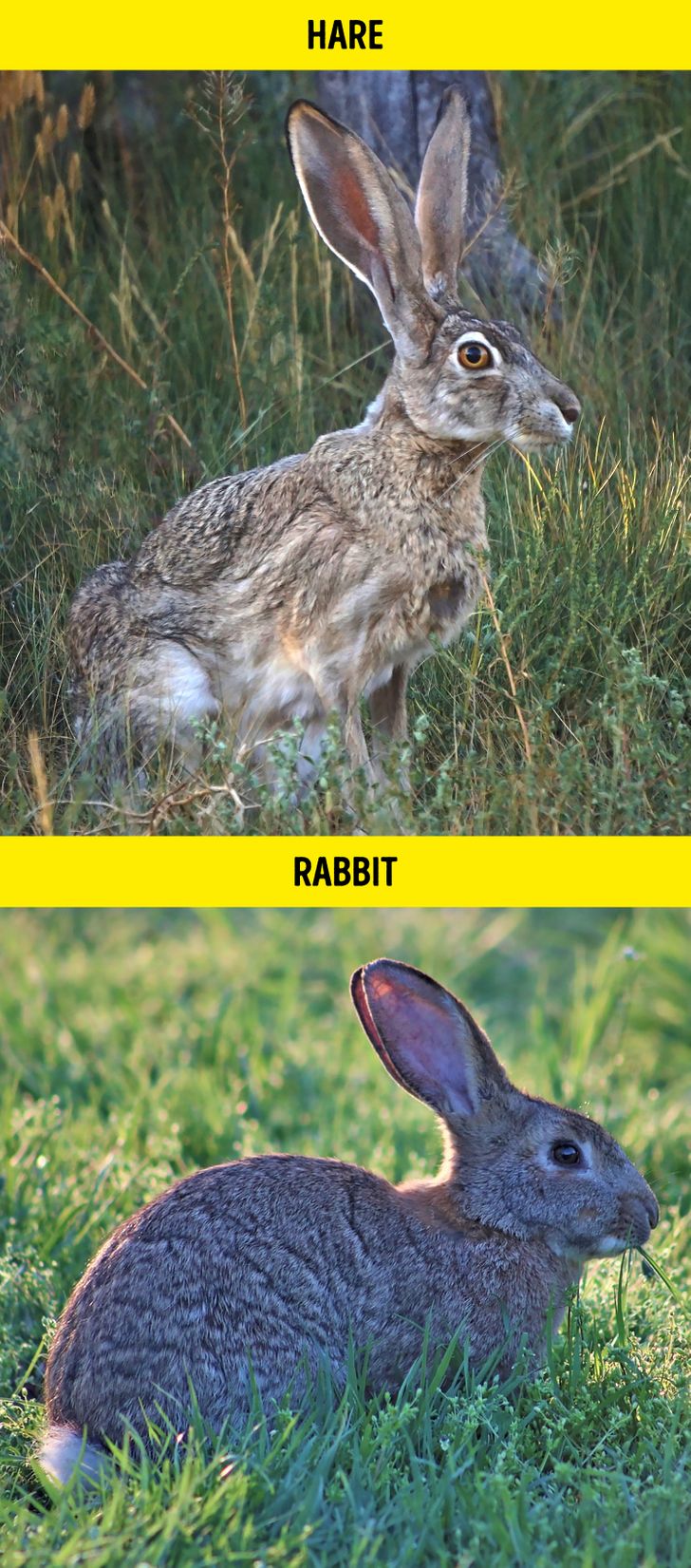
If you want a cuddly little pet, a rabbit is your best bet, but a hare definitely is not. Hares are larger and faster and have longer legs and ears. Rabbits are smaller, fluffier, and overall “cuter.” They even eat different food: rabbits prefer vegetables (like carrots) and soft grass while hares prefer bark and twigs. Rabbits are social animals while hares tend to be solitary. It’s no wonder rabbits are easily domesticated while hares mostly stay feral.
9. Moth vs butterfly
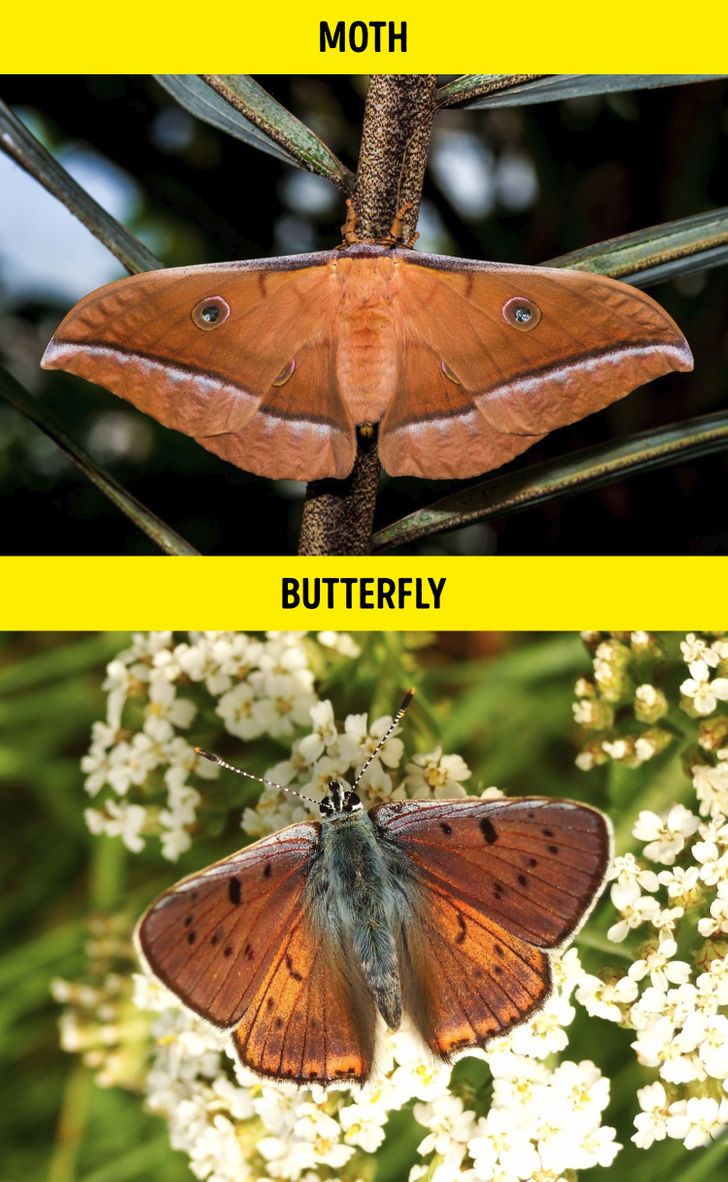
Moths have tent-like wings while butterflies flap their wings vertically. Moths usually rest with their wings open, while butterflies rest with their wings closed. Their antennas also differ: butterflies’ are long and thin and moths’ are short and feathery. Butterflies are strictly diurnal, while moths are mostly nocturnal.
10. Dolphin vs porpoise
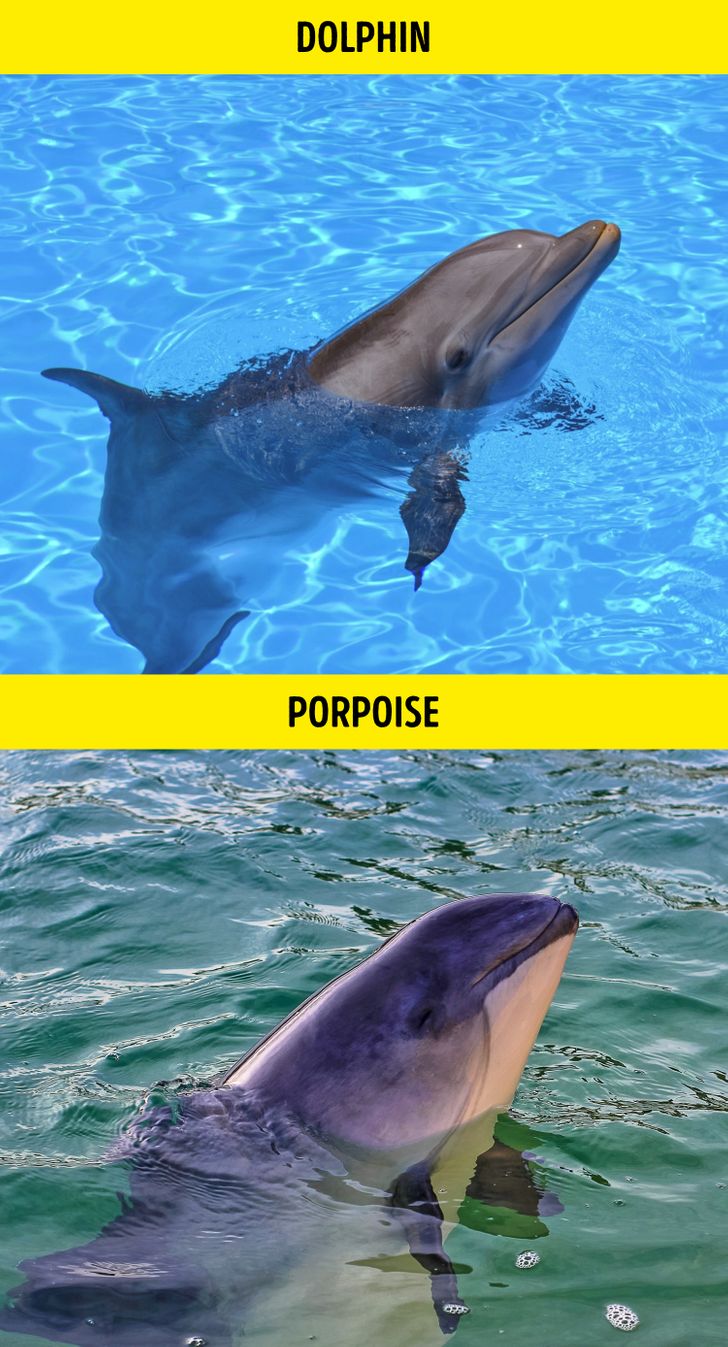
The difference between dolphins and porpoises comes down to their snouts, fins, and figures. Dolphins have long “beaks,” slender bodies, and curved dorsal fins. Porpoises have more flat, sloping faces, smaller flippers, and shorter triangular dorsal fins.
11. Weasel vs stoat
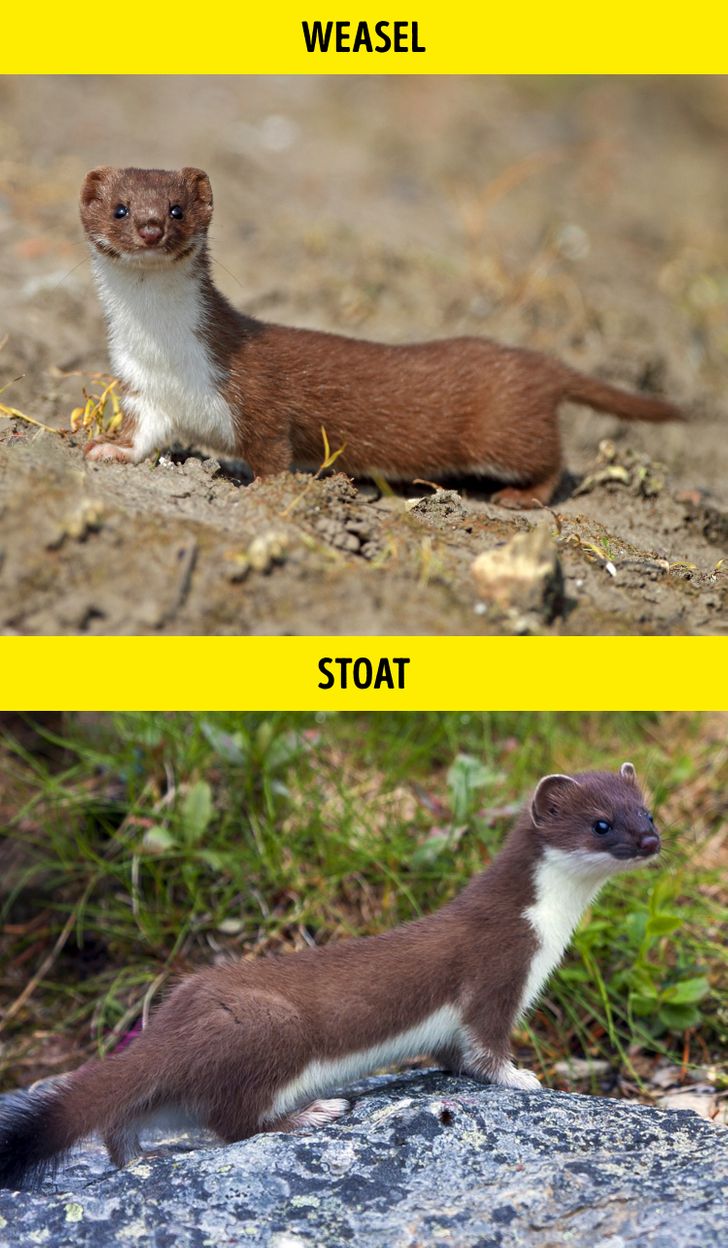
These 2 animals are close relatives. Stoats are bigger and have long tails with fuzzy black tips, while weasels’ tails are short and of the same color as the rest of the body. Stoats move in a bouncing gait with an arched back which looks hilarious, and weasels keep closer to the ground. Stoats also turn white in winter.
12. Eagle vs hawk vs falcon
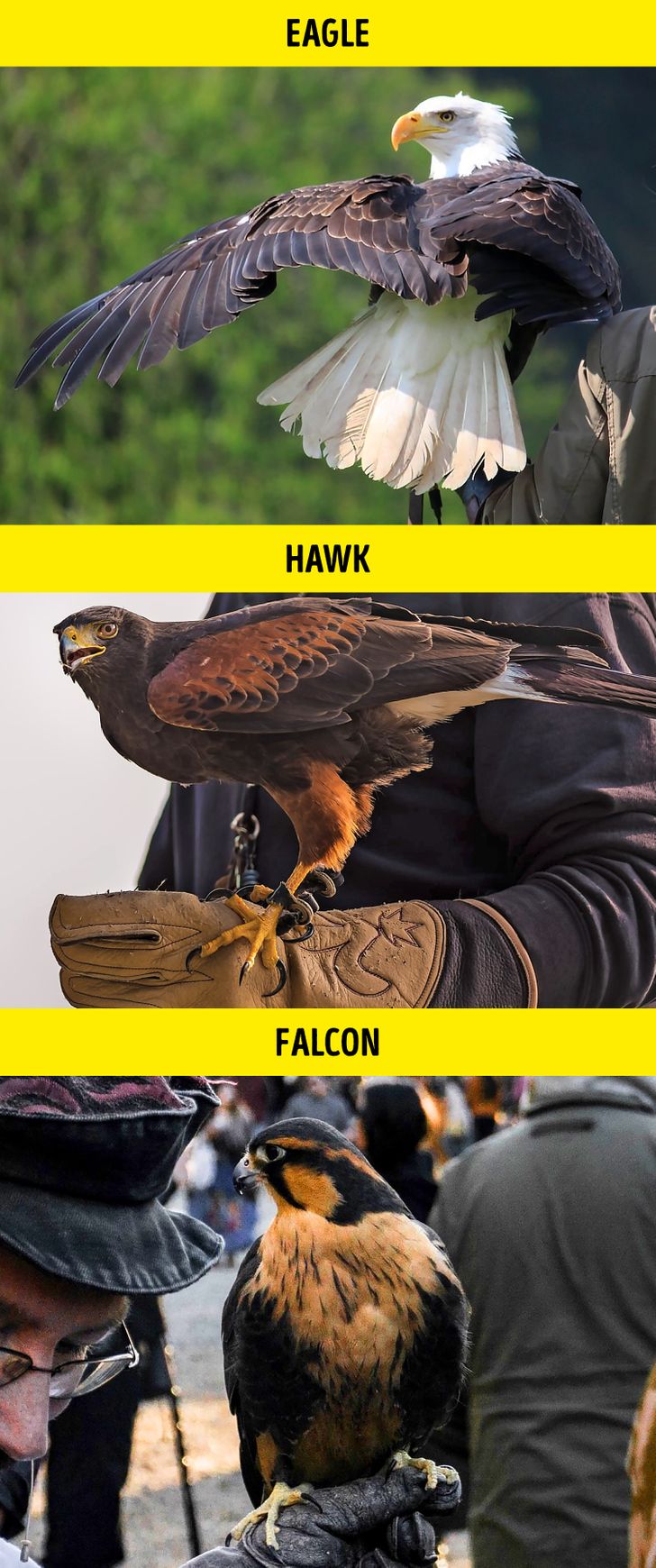
Eagles are gigantic, powerful birds who prefer to live in open spaces like cliffs and mountains. Hawks are a little smaller and more nimble in the air, capable of maneuvering in more closed areas. Falcons are the smallest and fastest of the 3 and differentiate the most visually: they have larger eyes and shorter beaks.
13. Mouse vs rat
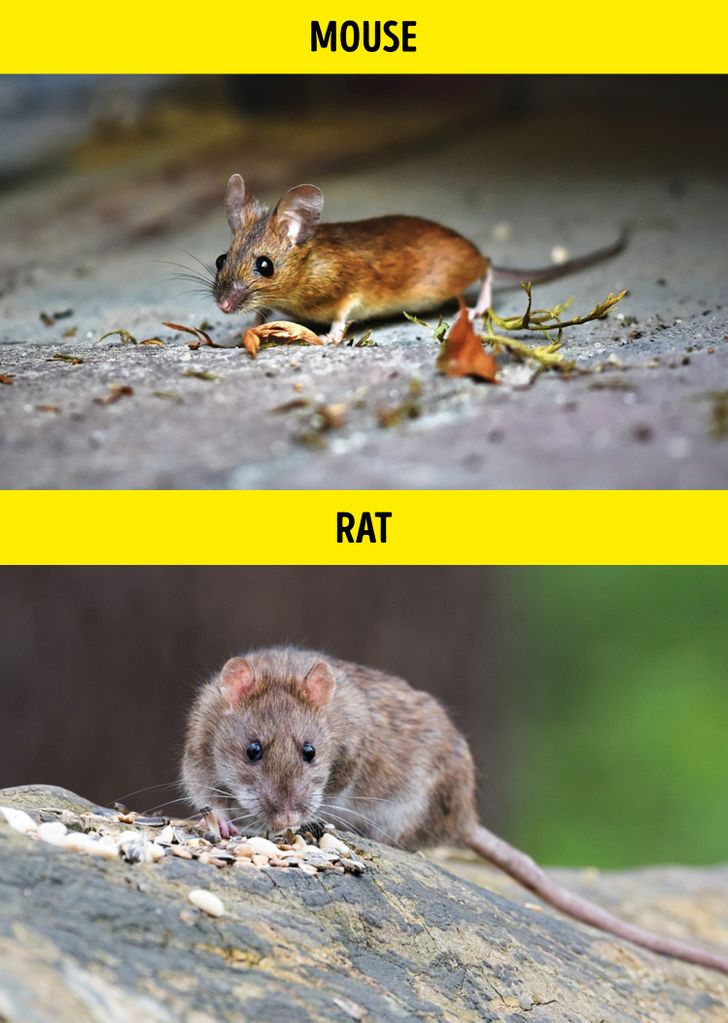
The 2 most famous (or infamous) rodents can be easily distinguished by 3 things: their size, tail, and ears. Mice are diminutive, even compared to young rats; they have thin long tails covered with fur while rats’ tails are thick and hairless. Mice have ears that are bigger in proportion to their bodies and are round and floppy with a tiny, triangular face. Rats’ faces are more prominent and blunt.
14. Seagull vs albatross
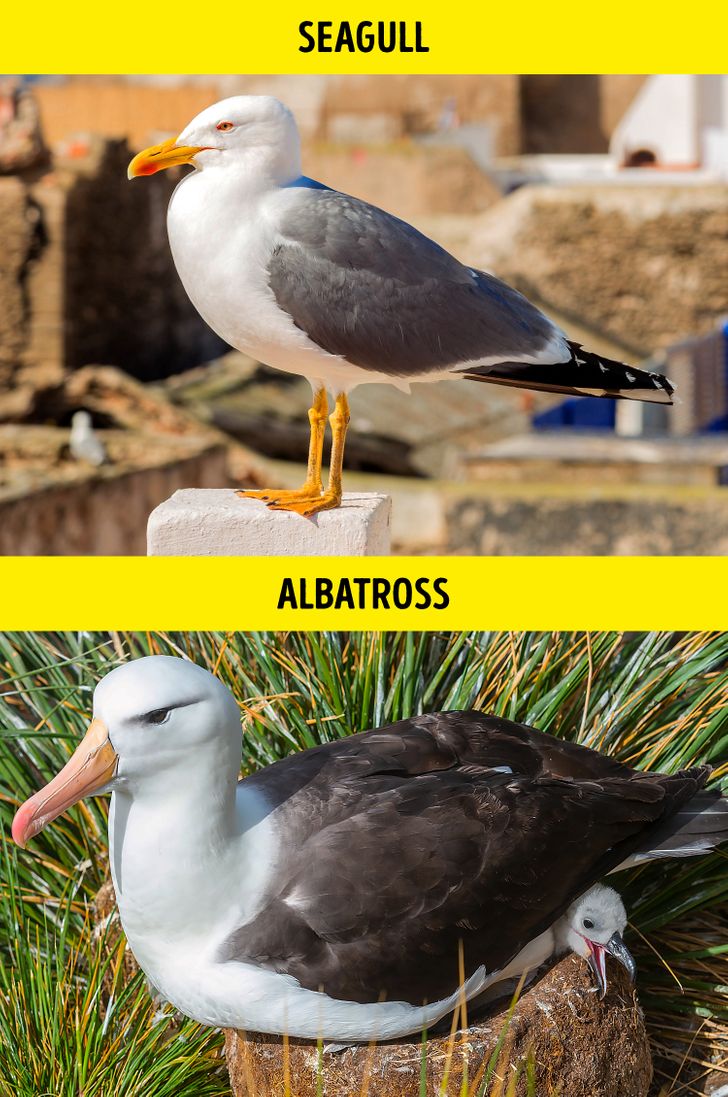
Gulls often live near water, be it the sea or ponds, and are rather acrobatic while diving and fish-catching, but aren’t fans of long voyages, unlike albatrosses. Albatrosses are portly birds who live in constant flight over the sea. They even have unique nostrils that allow them to remove salt from water and food.
15. Wolverine vs honey badger
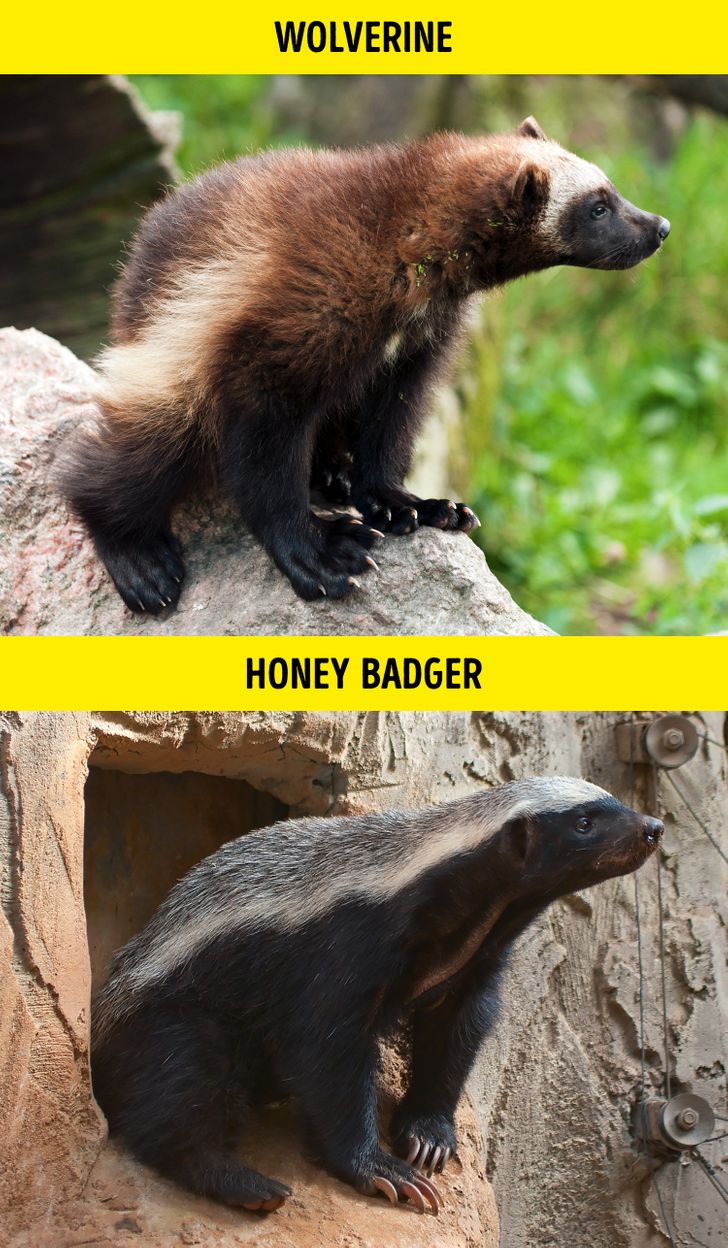
Despite living in different climate zones — the honey badger that lives in Africa and the wolverine that resides in the northern forests — both belong to the Mustelidae family. Wolverines are taller with longer legs and noticeable ears and have brown fur with yellow rings. Honey badgers keep closer to the ground and have black bodies with a white “cape” on their backs.
16. Wolf vs coyote vs jackal
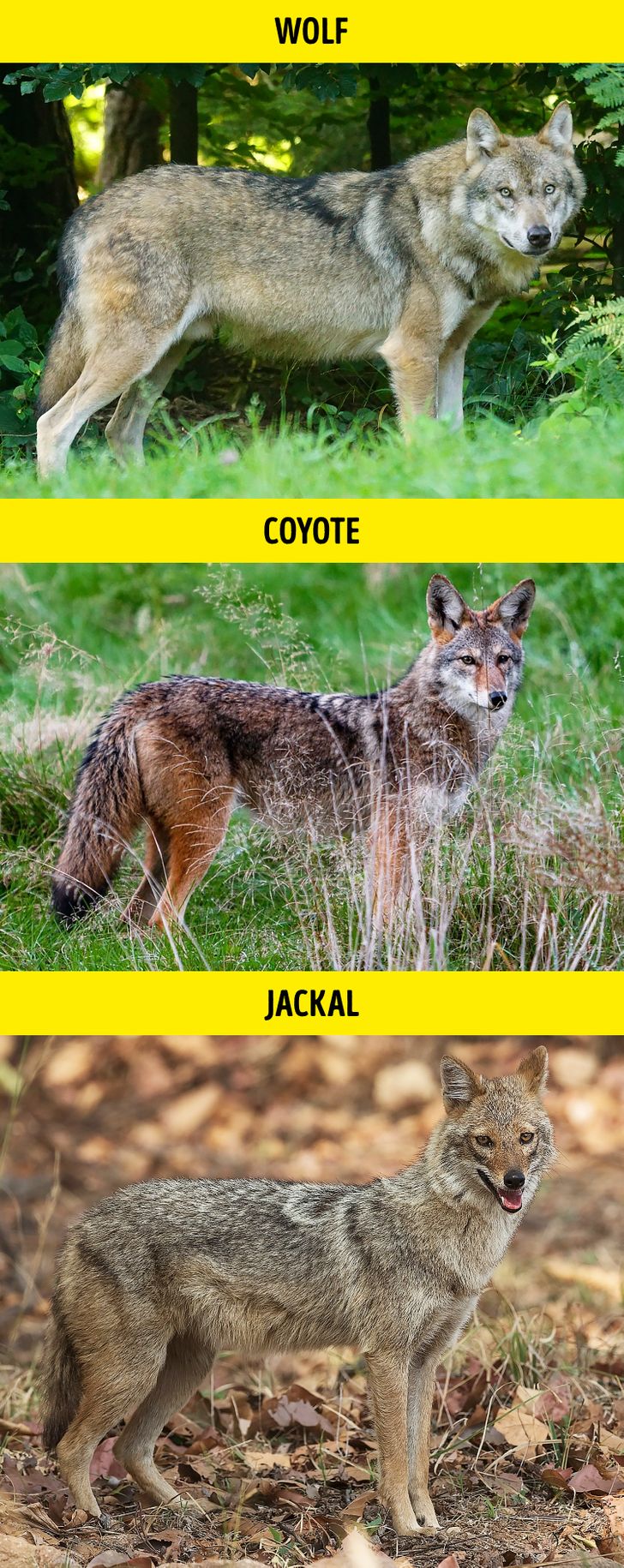
These 3 are “good boys and girls” that parade all over the globe. Jackals live in Africa, Asia, and India; coyotes live in Northern America; and wolves live all over the place. Wolves are large, sturdy animals, while coyotes and jackals possess a more lean and fragile frame.
Coyotes are recognizable for the red fur on their faces and ears while jackals have a more yellow-colored coat. Additionally, jackals are noticeably less fluffy because they don’t have to endure the harshness of winter.
Funny bonus: Wolverine vs the honey badger
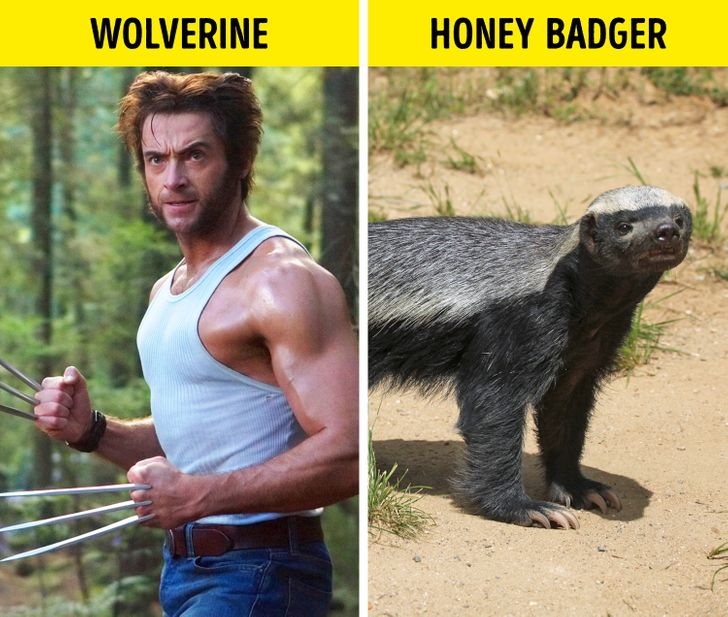
What kinds of animals have ever confused you? If you know more examples, share them in the comments!
Preview photo credit shutterstock.com, shutterstock.com
Telhadista descobre um esconderijo secreto na chaminé de uma senhora idosa e pobre

Após décadas de dignidade silenciosa em sua casa vitoriana em ruínas, a idosa Nancy aceita relutantemente a ajuda de um pedreiro local. Mas a descoberta dele na chaminé da casa de sua infância a força a confrontar um legado familiar doloroso que ela manteve escondido desde a trágica queda de seu pai.
Eu nunca quis ser o anjo da guarda do bairro. Esse título veio depois, depois de tudo o que aconteceu com o telhado e o que encontramos dentro dele. É engraçado como a vida funciona — às vezes as maiores mudanças acontecem bem quando você acha que não tem mais nada para dar.

Uma mulher sentada na varanda | Fonte: Midjourney
Minha casa vitoriana na Maple Street era algo especial quando papai estava vivo. Hoje em dia, a tinta descasca como pele queimada pelo sol, e a varanda cede como ombros cansados.
Mas é nosso lar e tem sido assim desde 1952, quando papai nos mudou pela primeira vez, orgulhoso como um pavão em sua melhor roupa de domingo.
“Nancy”, ele dizia, ajeitando sua gravata borboleta no vidro chanfrado da nossa porta da frente, “lembre-se de que a integridade vale mais que ouro”.
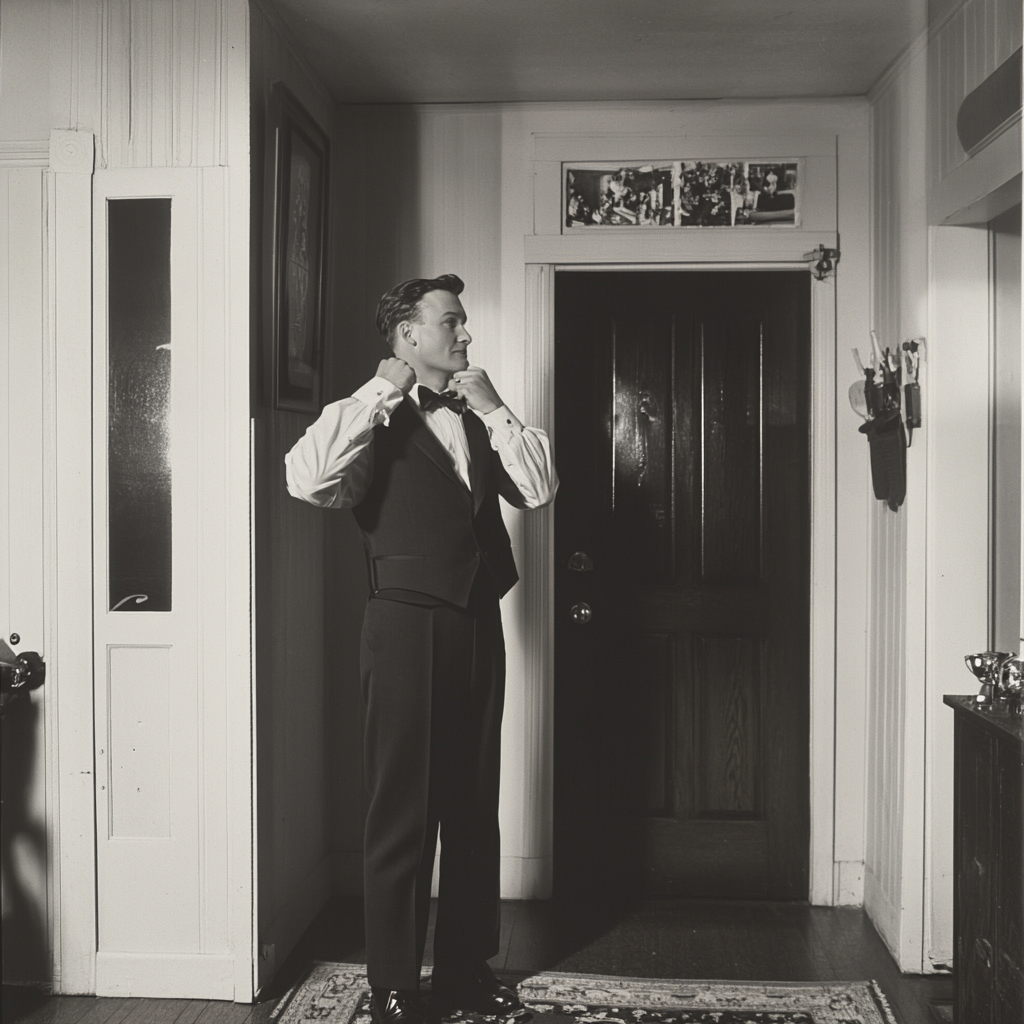
Um homem olhando no espelho | Fonte: Midjourney
Eu assenti, sem entender muito bem o que ele queria dizer. Não naquela época, pelo menos.
A casa já tinha visto dias melhores, assim como eu. Depois do meu divórcio de Thomas (“Não é você, Nancy, é só que… tem outra pessoa”), eu me joguei na manutenção do lugar. Mas o tempo tem um jeito de desgastar tudo, até mesmo a determinação.
A Sra. Chen, da casa ao lado, às vezes me trazia bolinhos, com preocupação estampada em seu rosto. “Você trabalha muito duro, Nancy. Deixe seus filhos ajudarem.”

Uma mulher segurando um prato de bolinhos | Fonte: Midjourney
“Sem crianças para ajudar”, eu respondia com um sorriso treinado. “Só eu e a casa agora.”
Isso sempre me rendia uma porção extra de bolinhos e um tapinha preocupado na mão.
As chuvas de inverno chegaram cedo naquele ano, encontrando cada rachadura no meu velho telhado. Fiquei na cozinha, observando a água pingar em uma coleção de tigelas e potes de mistura, cada um batendo como um pequeno martelo no meu orgulho.
“Isso não vai dar certo”, murmurei para mim mesmo.

Uma mulher olhando preocupada para recipientes cheios de água | Fonte: Midjourney
Ultimamente, falo comigo mesmo com mais frequência do que não falo. Viver sozinho faz isso com você, especialmente depois de 72 anos de vida e um casamento fracassado no qual tento não pensar mais.
Robert me viu mexendo com aqueles potes uma manhã. Ele morava três portas abaixo e tinha um negócio de telhados que o mantinha ocupado o suficiente. Eu o observava às vezes, saindo cedo em sua caminhonete branca, com as ferramentas chacoalhando na traseira.
“Srta. Nancy”, ele gritou, cruzando meu gramado. “Não pude deixar de notar que você tem um problema aí em cima.”

Um homem olhando para uma casa velha | Fonte: Midjourney
Endireitei meu cardigan, tentando parecer mais arrumada do que me sentia. “Oh, não é nada sério, Robert. Só algumas gotas aqui e ali.”
Ele olhou para o meu telhado, com as mãos nos quadris. “Esses ‘poucos pingos’ vão se transformar em problemas maiores se não os consertarmos. Deixe-me ajudar.”
“Eu não poderia possivelmente—”
“Sem custos”, ele interrompeu, levantando uma mão calejada.

Um homem sorridente | Fonte: Midjourney
“Considere isso uma vingança por todas as vezes que você cuidou dos meus filhos quando Sarah estava doente.”
Minha garganta apertou. “Sério, Robert? Os biscoitos que eu fiz para eles foram pagamento suficiente?”
“Aqueles biscoitos de chocolate podem ter valido seu peso em ouro”, ele riu, “mas isso é diferente. Nem todo serviço tem um preço. Lembra quando Tommy estava com gripe e você ficou acordado a noite toda com ele?”
Eu me lembrei.

Uma mulher atenciosa | Fonte: Midjourney
Tommy era tão pequeno então, ardendo de febre. Sarah estava no hospital, e Robert parecia prestes a desmaiar de preocupação.
“Sra. Nancy”, ele disse, com a voz gentil, mas firme, “às vezes você precisa deixar as pessoas te ajudarem, do mesmo jeito que você tem ajudado as pessoas aqui há anos.”
Eu queria discutir, mas o barulho de outro gotejamento na minha cozinha fez a decisão por mim. “Bem, se você tem certeza de que não é problema…”

Uma mulher resignada | Fonte: Midjourney
Na manhã seguinte, Robert apareceu com sua escada e ferramentas. As crianças da vizinhança se reuniram para vê-lo trabalhar, e eu as mandei embora com promessas de biscoitos fresquinhos mais tarde.
“Meu pai diz que você é a mulher mais simpática da rua”, declarou a pequena Maria Martinez, com suas tranças balançando enquanto ela pulava.
“Seu pai é muito gentil”, respondi, mas suas palavras aqueceram algo dentro de mim que os anos haviam esfriado.
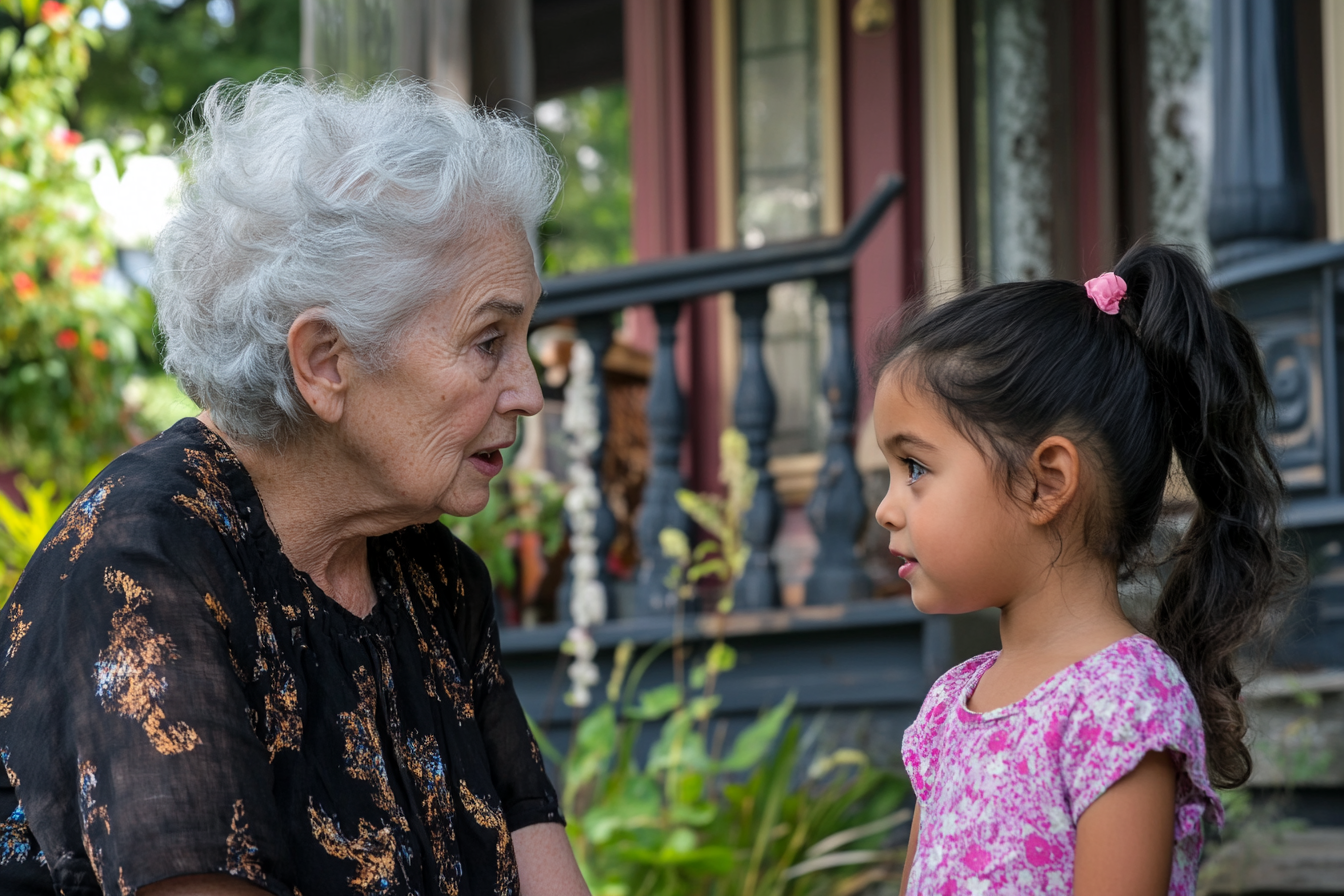
Uma mulher conversando com uma garota | Fonte: Midjourney
Observei de baixo enquanto Robert se movia pelo meu telhado com a firmeza de alguém que já tinha feito isso mil vezes antes. O sol da manhã iluminou suas ferramentas, enviando breves flashes de luz pelo quintal como código morse.
“Está tudo bem aí em cima?”, gritei quando ele ficou quieto por muito tempo.
“Só checando sua chaminé”, ele gritou de volta. “Espere um minuto… tem alguma coisa—”
O som de tijolo raspando contra tijolo me fez estremecer. Então silêncio.

Uma mulher olhando para o telhado de uma casa velha | Fonte: Midjourney
Sons suaves ecoaram do telhado, mas Robert ainda não disse nada. Eu estava começando a ficar preocupado quando sua voz foi ouvida.
“Sra. Nancy?” A voz de Robert mudou, ficou mais tensa de alguma forma. “Acho melhor você ver isso.”
Ele desceu com cuidado, segurando algo contra o peito. Não consegui entender o que era até que ele chegou ao pé da escada e se virou para mim. Em suas mãos estava uma bolsa de couro, escura com a idade e a poeira.

Um homem segurando uma bolsa de couro | Fonte: Midjourney
Meu coração pulou uma batida. Eu não o via há anos, mas o reconheci imediatamente. Eu sabia o que havia dentro dele também, mas deixei que ele me mostrasse, de qualquer forma.
Moedas de ouro brilhavam ao sol, as joias antigas da mamãe brilhavam e os diamantes nos quais o papai havia investido antes de tudo dar errado brilhavam como neve fresca.
As mãos de Robert tremeram levemente. “Isso deve valer uma fortuna.”
Observei seu rosto cuidadosamente e vi a guerra se desenrolando atrás de seus olhos.
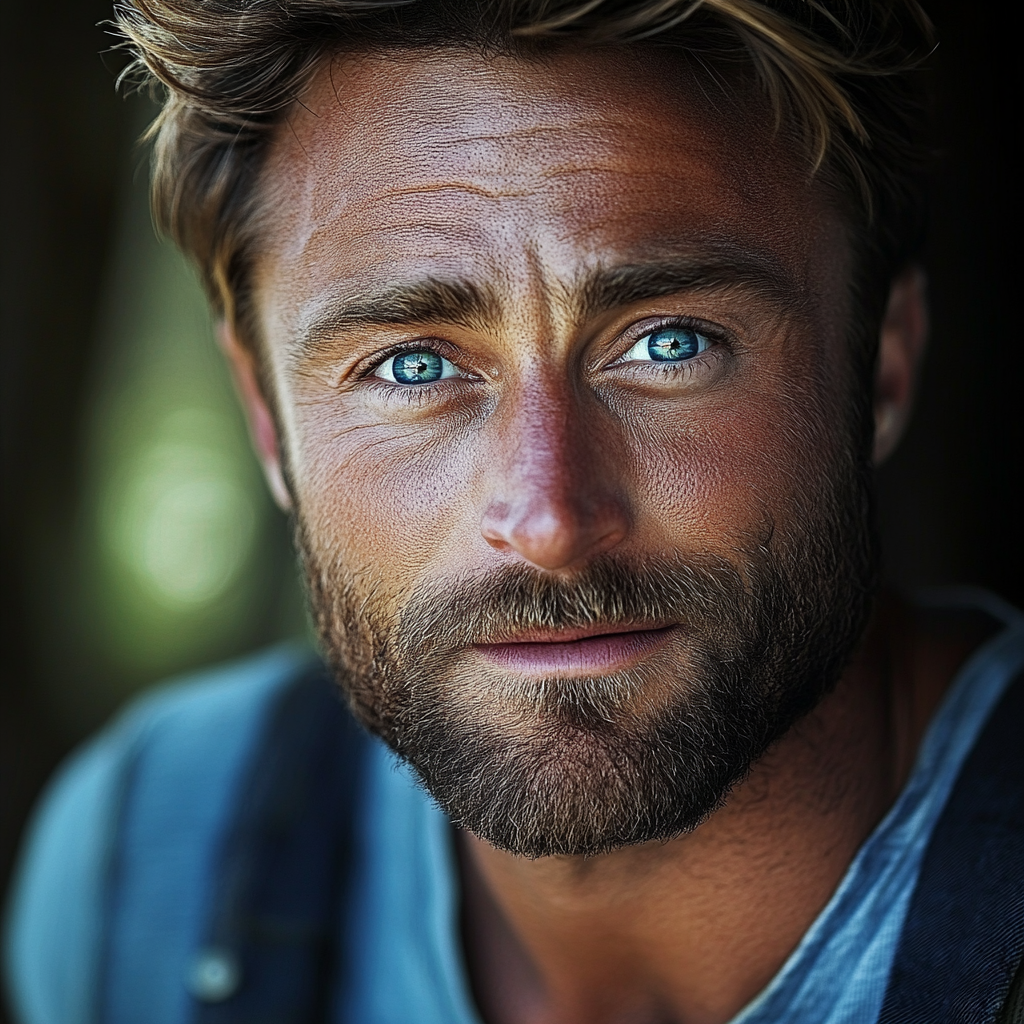
Um homem de olhos arregalados | Fonte: Midjourney
Ele tinha três filhos em casa, uma hipoteca para pagar e sonhos que ele havia deixado de lado para manter comida na mesa. Aquela bolsa continha o suficiente para mudar tudo para ele.
“Eu…” ele começou, então engoliu em seco. “Isso pertence a você, Srta. Nancy. É sua casa, sua família…”
Coloquei minha mão sobre a dele. “Você é um bom homem, Robert Miller. Assim como meu pai era.”
Seus olhos encontraram os meus, confusos. “Você sabia disso?”
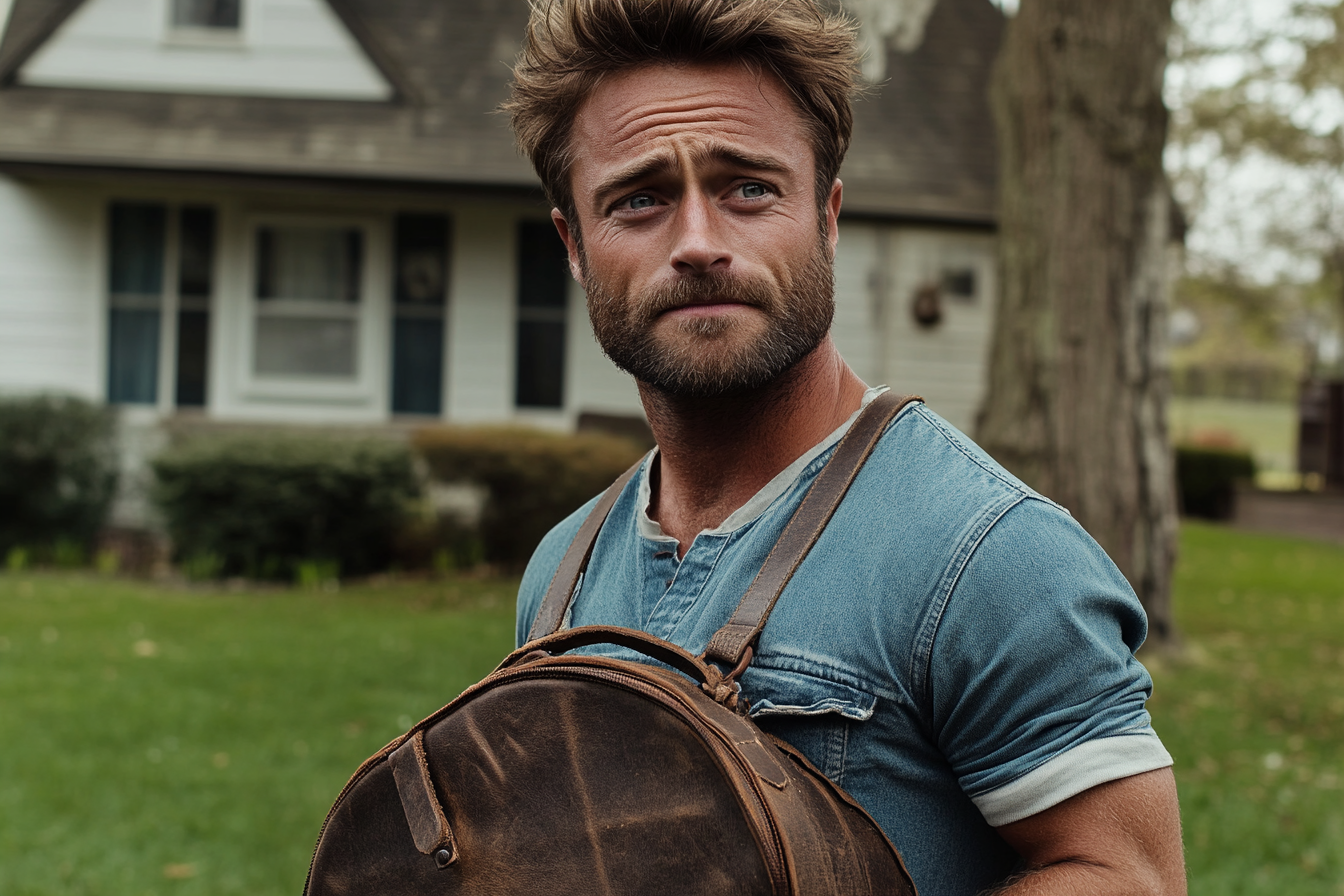
Um homem segurando uma bolsa de couro | Fonte: Midjourney
Eu assenti, levando-o até meu balanço na varanda. “Papai escondeu lá antes de morrer. Ele disse que seus parceiros de negócios estavam ficando gananciosos, e que algo não parecia certo. Ele provou que estava certo um mês depois, quando o forçaram a sair de sua própria empresa.”
“Mas por que você nunca usou isso? Todos esses anos, lutando…”
Sorri, observando os filhos da Sra. Peterson brincando de amarelinha do outro lado da rua. “Porque papai também me ensinou que dinheiro não é o que faz uma vida valer a pena. Escolhi ser rica de outras maneiras.”
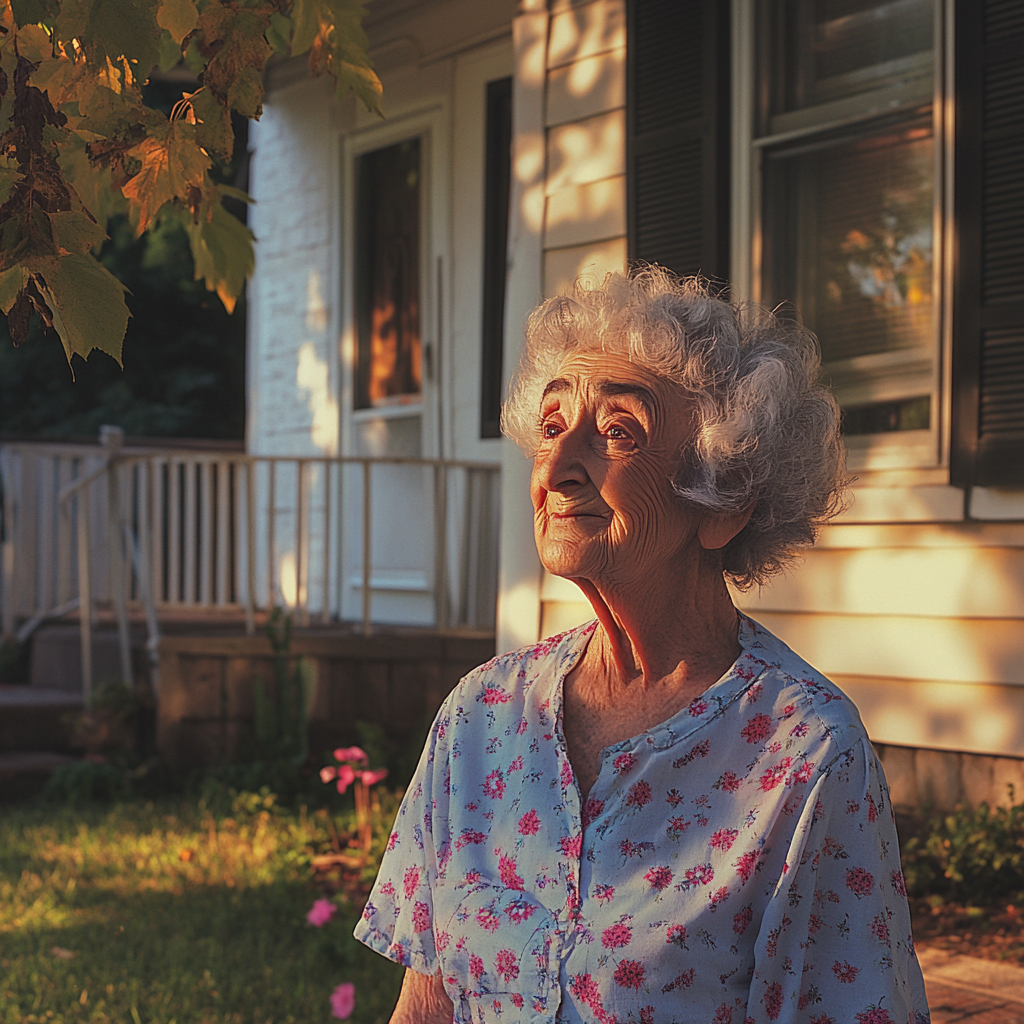
Uma mulher sorridente | Fonte: Midjourney
“Como o quê?”, Robert perguntou suavemente, com a bolsa pesada no colo.
“Como o primeiro sorriso de Tommy depois que sua febre passou. Como a mãe de Maria aprendendo inglês na minha cozinha tomando café, e observando Sarah se recuperar e sabendo que eu ajudei, mesmo que só um pouco.” Dei um tapinha na mão dele. “Como ter vizinhos que percebem quando meu telhado vaza.”
Robert sentou-se em silêncio por um momento. “Acho que consigo entender de onde você está vindo. Mas você não pode simplesmente deixar isso parado na sua chaminé, Srta. Nancy. O que você quer fazer com isso?”

Um homem sentado em um balanço da varanda | Fonte: Midjourney
“Eu acho”, eu disse lentamente, “que é hora de colocar esse dinheiro para render. Do jeito que o papai gostaria.”
Nas semanas seguintes, Robert me ajudou a vender tudo, e eu distribuí entre as famílias do meu bairro. A família Martinez conseguiu o suficiente para mandar o filho mais velho para a faculdade.
“Mas, Srta. Nancy”, protestou a Sra. Martinez, com lágrimas nos olhos, “isso é demais!”
“A educação era tudo para meu pai”, eu disse a ela. “Vamos honrar isso.”

Duas mulheres falando | Fonte: Midjourney
Os Wilsons finalmente consertaram o telhado também. O centro comunitário ganhou novos computadores, e o playground ganhou aquela superfície de segurança de que precisava há anos. Cada presente veio com uma história sobre meu pai, sobre integridade e sobre comunidade.
“Você tem que tomar um pouco”, insisti para Robert quando estava quase acabando. “Pela sua honestidade, se nada mais.”
Ele tentou recusar, mas eu não quis ouvir falar nisso.
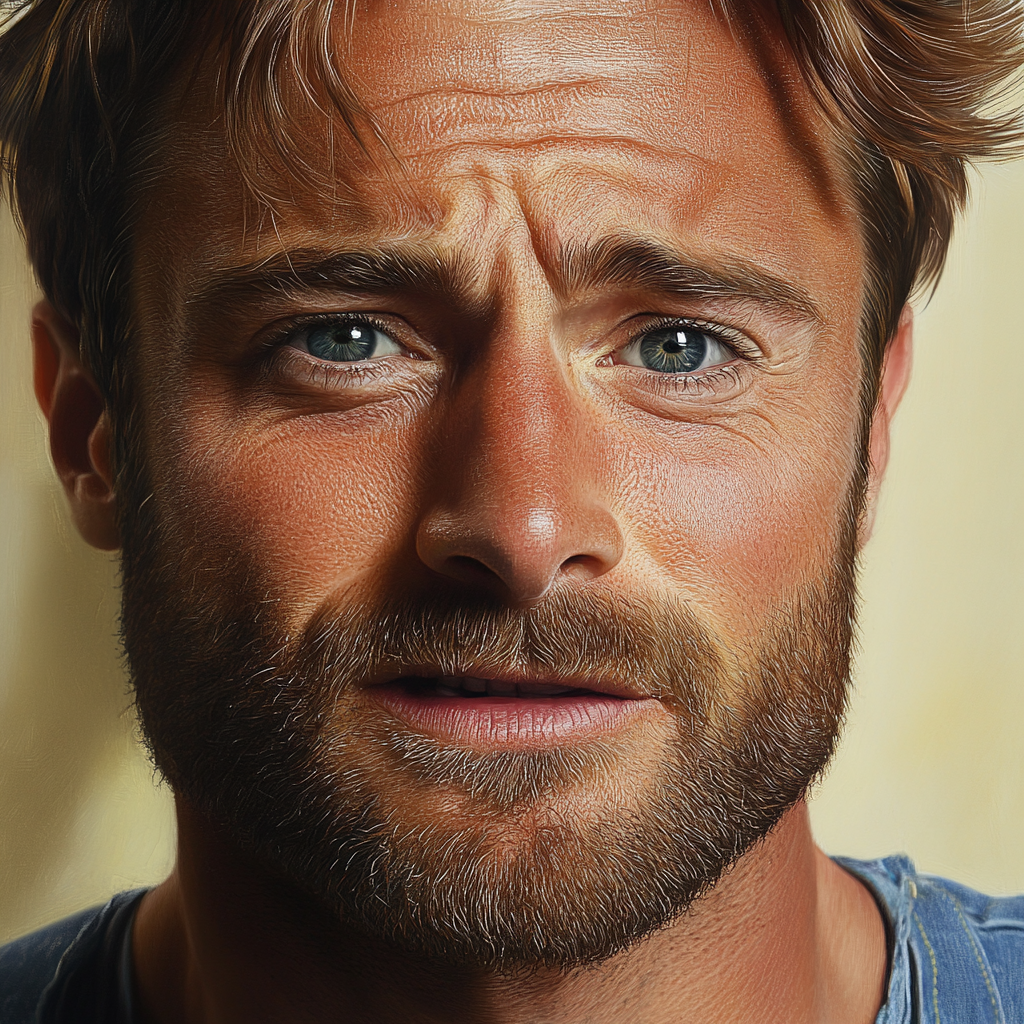
Um homem emocional | Fonte: Midjourney
“Sua integridade vale mais que ouro”, eu disse a ele, “mas isso não significa que você não deva ser recompensado por ela”.
O bairro mudou depois disso. Não muito — as casas ainda eram velhas, e as ruas ainda precisavam de reparos. Mas havia algo diferente no ar, algo que parecia esperança.
Uma noite, enquanto eu estava sentado na varanda assistindo ao pôr do sol, a pequena Amy apareceu correndo com um punhado de dentes-de-leão.
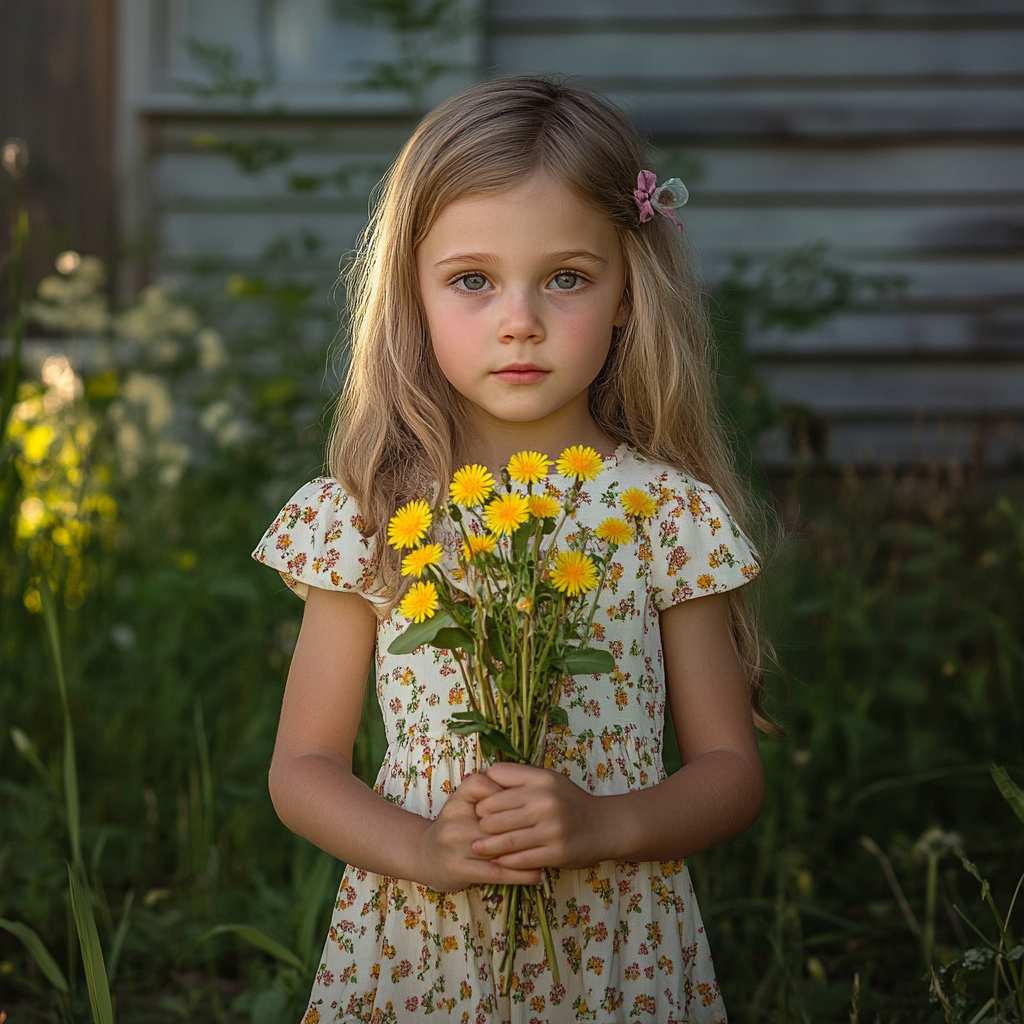
Uma menina segurando um buquê de dentes-de-leão | Fonte: Midjourney
“Esses são para você”, ela disse, colocando-os em minhas mãos. “Mamãe disse que você é nosso anjo da guarda.”
Eu ri, colocando uma das flores amarelas atrás da orelha dela. “Não, querida. Eu sou apenas alguém que aprendeu que o verdadeiro tesouro não é o que você guarda — é o que você dá.”
“Gostou dos seus biscoitos?” ela perguntou séria.
“Gosto dos meus cookies”, concordei. “E gosto do amor que é colocado em fazê-los.”
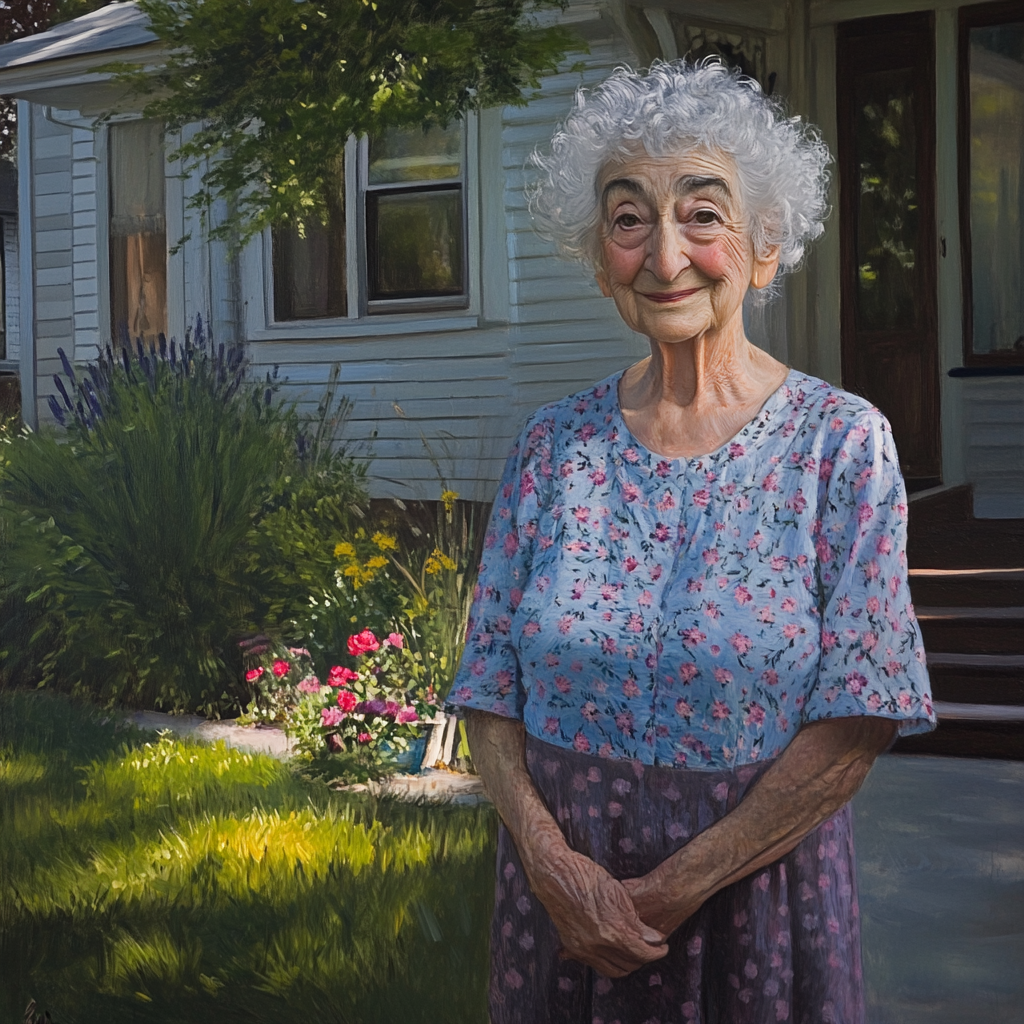
Uma mulher sorridente em pé na frente de sua casa | Fonte: Midjourney
Enquanto eu a observava voltando para casa, pensei no papai e suas lições sobre integridade, em Robert e sua escolha de ser honesto, e em todas as maneiras como a riqueza pode ser medida.
Meu novo vizinho estava tornando minha vida um inferno entre seu corte de lenha ao amanhecer e aquele cachorro destrutivo. Estávamos à beira de uma guerra total quando sua filha de sete anos apareceu chorando na minha porta com um apelo desesperado por ajuda.
Este trabalho é inspirado em eventos e pessoas reais, mas foi ficcionalizado para fins criativos. Nomes, personagens e detalhes foram alterados para proteger a privacidade e melhorar a narrativa. Qualquer semelhança com pessoas reais, vivas ou mortas, ou eventos reais é mera coincidência e não intencional do autor.
O autor e a editora não fazem nenhuma reivindicação quanto à precisão dos eventos ou à representação dos personagens e não são responsáveis por nenhuma interpretação errônea. Esta história é fornecida “como está”, e quaisquer opiniões expressas são as dos personagens e não refletem as opiniões do autor ou da editora.



Leave a Reply